

Www.ok.gov/sde/sites/ok.gov.sde/files/Targeting Growth.pdf. K-12 Education Tips & Strategies That Work. Lessons Worth Sharing. Kathy Schrock's Home Page. Lesson Plan Search – Google in Education. Better Lessons - Free Lesson Plans. Math english language arts Kindergarten Counting & Cardinality Operations & Algebraic Thinking.
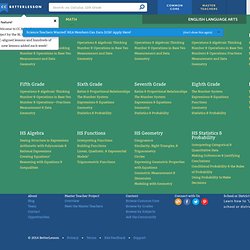
Share My Lesson - Free K-12 Resources By Teachers, For Teachers. WorksheetWorks.com. Lesson Plans & Interactives. Share My Lesson - Free K-12 Lesson Plans & Teaching Resources. 65 Free Interactive Whiteboard Resources. Interactive whiteboard resources are a great way for teachers to engage classrooms in learning.
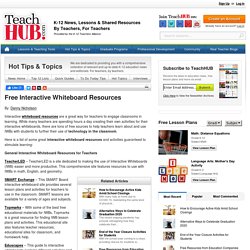
While many teachers are spending hours a day creating their own activities for their interactive whiteboards, there are tons of free sources to help teachers learn about and use IWBs with students to further their use of technology in the classroom. Here is a list of some great interactive whiteboard resources and activities guaranteed to stimulate learning: General Interactive Whiteboard Resources for Teachers TeacherLED – TeacherLED is a site dedicated to making the use of Interactive Whiteboards (IWB) easier and more productive. This comprehensive site features resources to use with IWBs in math, English, and geometry. With many kids at home due to COVID-19, maintaining the same level of physical... The recent ongoing pandemic has schools reimagining how they celebrate their... With the school year coming to a close, providing closure for students is... How to Flip Your Classroom With eduClipper and PixiClip.
Open source e-learning and collaboration software. Edmodo. Sophia - Integrated Online Classroom. Kickboard - Monitor Student's Progress. ClassDojo - Class Behavior Improvement Tool. LessonPaths - Create, share and explore Learning Playlists - LessonPaths. Planboard — Lesson planning made easy for teachers and educators.
Infographics. QR Codes in the Classroom. TeacherTube - Teach the World. PowerPoint Presentations free to download. Teachers and students. Free Technology for Teachers. Free Books - 23,469 Classics To Go - The Ultimate Ebooks And Audiobooks Library In Your Pocket. Educreations - Teach what you know. Learn what you don't.
TrackStar : Home. RubiStar Home. Using Badges in the Classroom to Motivate Learning. Gold stars, Girl Scout badges, and Boy Scout badges—when we think about motivating our students to assist them in their learning and development, using badges in the classroom have a similar function as many of the rewards we were offered as young learners in primary schools (Ash, 2012).

As a motivational tool, badges can be added to your college classroom using a fairly streamlined process, and with little or no cost to you at an individual level, or at an institutional level. Why use badges in the classroom? There are several reasons why you might want to use badges in the classroom. First, they recognize accomplishments and provide students with a tangible (albeit virtual) reward that acknowledges an achievement, whether it is a skill, competency, or completed task. Second, badges provide greater opportunities for student collaboration, cooperation, and interaction, as students motivate and encourage one another, and compete with one another to earn various badges in the classroom. What Is Active Learning? Defining "active learning" is a bit problematic.
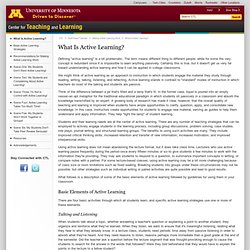
The term means different thing to different people, while for some the very concept is redundant since it is impossible to learn anything passively. Certainly this is true, but it doesn't get us very far toward understanding active learning and how it can be applied in college classrooms. We might think of active learning as an approach to instruction in which students engage the material they study through reading, writing, talking, listening, and reflecting. Active learning stands in contrast to "standard" modes of instruction in which teachers do most of the talking and students are passive. Think of the difference between a jar that's filled and a lamp that's lit.
Students and their learning needs are at the center of active learning. Using active learning does not mean abandoning the lecture format, but it does take class time. Some Basic Active Learning Strategies. Engaging students in individual or small group activities–pairs or trios especially–is a low-risk strategy that ensures the participation of all.
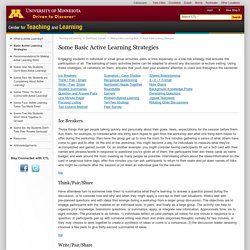
The sampling of basic activities below can be adapted to almost any discussion or lecture setting. Using these strategies, or variations on them, ensures that you'll hold your students' attention in class and throughout the semester. Ice Breakers Those things that get people talking quickly and personally about their goals, fears, expectations for the session before them. Ask them, for example, to consider what one thing each hopes to gain from the workshop and what one thing each hopes to offer during the workshop, then have the group get up to rove the room for five minutes gathering a sense of what others have come to gain and to offer.
Top Think/Pair/Share Write/Pair/Share The format for this strategy is identical to the think-pair-share, except that students process the question asked of them by writing about it rather than reflecting. Twelve Active Learning Strategies. Example 1 Example 1 Explanation In order for students to learn effectively, they must make connections between what they already know (prior knowledge) and new content to which they're exposed.
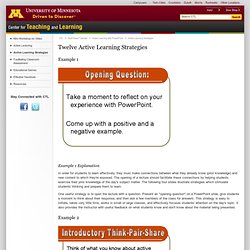
The opening of a lecture should facilitate these connections by helping students exercise their prior knowledge of the day's subject matter. Www.rubrics4teachers.com.